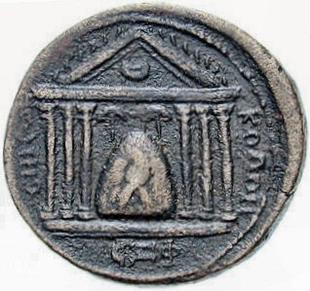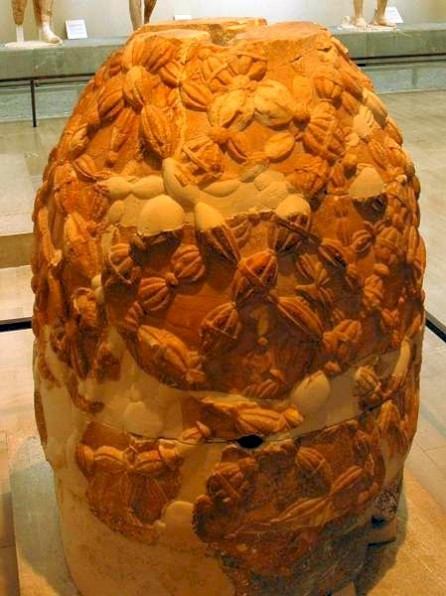Baetyl
Baetyl (or Baitylos, Beth-El): a venerated stone, believed to be in some sense the "house of god".

All over the ancient Levant, we find the cultic practice of venerating stones that were believed to be the house of a particular god, a Beth-El. For example, there were baetyls in the Phoenician cities Byblos and Tyre. In the hinterland of these ports, the sun god Elagabal of Emesa was venerated as a conic black stone that was protected by an eagle, the Syrian sun-bird (cf. the standing eagle visible in front of the conic baetyl on the coin). In the third century CE, the stone was believed to be a meteorite,note although we do not know whether it was really of celestial origin. Likewise, the Phrygian mother goddess Cybele was worshipped in Pessinus (later Rome) as a stone; this may have been a meteorite as well.

It is not entirely clear whether the baetyls themselves were the object of worship, or that they were symbols (or guarantees) of the divine presence. Probably there was confusion, just like Christians disagree whether the bread they share is Christ, guarantees the covenant with Christ, or symbolizes Christ.
The Bible mentions a town called Bethel; an echo of the old belief can be found in Psalm 28.1, where God is likened to to a rock, and at a later stage, the prophets of Israel and Judah polemized against the worshippers of these stones. In our own age, Muslims worship God in the Kaaba in Mecca, which contains a famous black stone that was already a cult object before the ministry of the prophet Muhammad.
The belief in baetyls was also known in the world of the Greeks, who venerated these stones in Paphos ("the needle of Aphrodite"), Ephesus (Artemis), and Delphi (Apollo). However, in the classical age, the Greeks no longer remembered the origin of this cult. To explain its significance, they said that once, in the mythological past, the supreme god Zeus had released two eagles at the edges of the earth, which had met each other above the sacred city. A monument was erected to celebrate the outcome of this mytho-scientific experiment: it was called the omphalos ('navel').

It is interesting to see that in the early third century, the Roman emperor Septimius Severus (193-211) built an umbiculus ('navel') in Rome. He may have been thinking about the Greek example, but it is also remarkable that Severus' wife Julia Domna was the daughter of the high priest of Elabal in Emesa.
It has been suggested that the Christian cult of Saint Simeon the Stylite (c.390-459), who used to live on a tall pillar that was after his death venerated by the Arabs, was an attempt to convert them to Christianity by offering them a stone to worship.